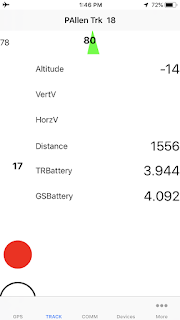With an upcoming M1101 flight planned in the Competitor, I decided to make some upgrades to the rocket. I'm expecting about 12,200 feet altitude and Mach 1.10.
I decided to upgrade my tracker. Previously, I was using the Com-Spec directional system, which works well but it's limited to only giving you a direction and relative signal strength.
I bought the
Featherweight GPS System. This system has a GPS module in the rocket which communicates to the ground station on the 900MHz band, which in turn communicates via Bluetooth to an app on my phone. This system will allow me to know exactly where the rocket is before even setting out to go recover it.
I designed and 3D printed a nice mount for the tracker to install into the Competitor's nose cone.
 |
| Featherweight GPS and Battery Installed in the Mount |
 |
GPS Mount Installed in Nose Cone
(The bulkplate secures it when installed.) |
I also finally made a proper camera mount. So far, I've only ever used packaging tape to secure the camera, but I wouldn't trust that for a supersonic flight. I designed and 3D printed a shroud. It is secured to the airframe tube with a singe sheet metal screw, and a copious amount of JB Weld. I sanded the paint off the tube in the area to ensure a secure bond was obtained.
 |
Sanding/Scoring the Tube
(I actually did most of the area that is covered by
the shroud, but I didn't take a picture of that.) |
 |
| The Mobius Camera Mounted in its Shroud |
















